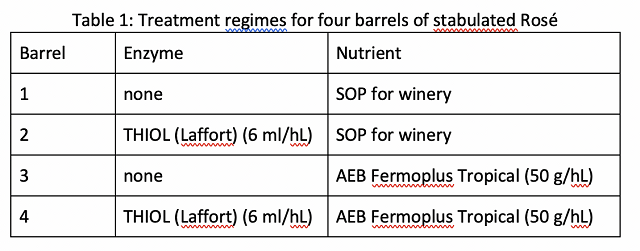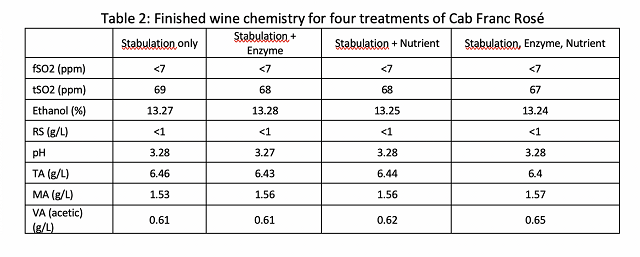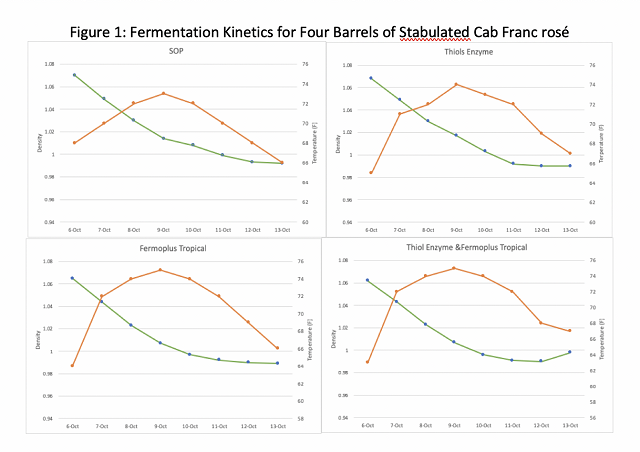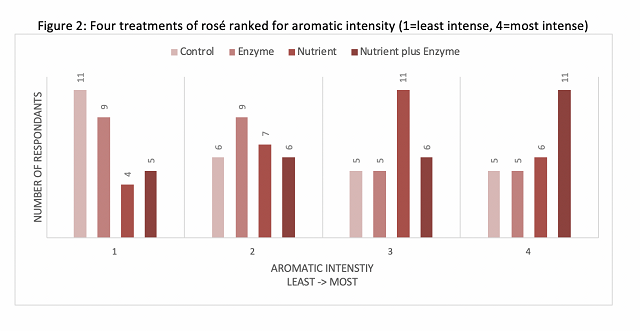Developing a protocol for rosé stabulation using Laffazyme THIOLS (Laffort) and Fermoplus Tropical (AEB)(2018)
Tim Gorman
Cardinal Point Winery
Summary
Based on results of previous studies of stabulation focusing on thiol production in rosé and Sauvignon Blanc, Cardinal Point has decided to adopt stabulation in the production of its Cabernet Franc based rosé. To develop the protocol, several elements of a thiol-producing approach were tested individually and in concert including use of THIOLS (Laffort) enzyme and Fermoplus Tropical (AEB) nutrient. All treatments in the trial received stabulation, with addition of enzyme and nutrient both separately and together. Finished wine chemistry was the same for all treatments. In a ranking test for aromatic intensity, the wine treated with both enzyme and specialized nutrient ranked significantly higher than the other treatments, however there were no significant differences among the wines for descriptors of thiol intensity or green/herbal quality.
Introduction
The character of Provençal style rosé is partially determined by the presence of thiols in the wine (Masson and Schneider 2009). SARCO lab has previously reported thiols (3MH and 3MHA) in rosé wines produced from a number of grapes including Merlot, Cabernet Franc, and Cabernet Sauvignon, irrespective of geographic origin. There are many steps in the production of wine that affects thiol expression, including interventions in the vineyard as well as the winery. Stabulation and enzyme treatment are both interventions designed to increase the extraction of thiol precursors from the juice pulp. Specialized yeast nutrients are also available to enhance aromatics of the wine by supplying components to optimize yeast metabolism.
The Applied Research Cooperative of Laffort tested the effects of stabulation and enzyme at 21 different winery locations in 2016, including two trials submitted by the WRE. In these trials, 12 of the 21 wines showed a significant difference in a triangle test, though preferences were split between stabulated and non-stabulated wines. ENose analysis showed significant differences between stabulated and non-stabulated wines, indicating the treatment did have an effect. Thiol analysis showed mixed results; of 8 trial wines tested, 5 showed increase in thiols with stabulation, 1 showed a decrease, and 2 had no significant difference between stabulated and non-stabulated wine. Treatment with thiolase enzyme had a larger effect on thiols than stabulation in 3 of 4 wines tested (Laffort, n.d.). Addition of specialized nutrition to this protocol could further enhance aromatic expression.
Based on results of previous studies on stabulation focusing on thiol production in rosé and Sauvignon Blanc, Cardinal Point has decided to adopt stabulation in the production of its Cabernet Franc based rosé. To develop the protocol, several elements of a thiol-producing approach were tested individually and in concert. Laffazyme THIOLS (Laffort) is a “pectolytic enzyme blend with secondary activity designed to proficiently increase yeast aromatic thiols revelation”. According to product information, this enzyme has been shown to have a statistically significant effect on 3MH and 3MHA thiols in the resulting wine and is designed to be used in conjunction with stabulation. Fermoplus Tropical (AEB) is a yeast autolysate nutrient that is formulated to increase amino acid uptake and increase production of an “aromatic tropical profile”.
Methods
Fruit was crushed and destemmed into TBins, layering pressing enzyme with Fermotan (AEB), SO2and CO2 to prevent oxidation. After maceration, fruit was pressed to tank with CO2 in the press and the pan. After pressing, the tank was cooled to 32°F for 4 days of stabulation with twice daily anaerobic stirring followed by blanketing with CO2. To accomplish this, a CO2 regulator was set to very slowly trickle gas into the must continuously. The tank was mixed twice per day by turning up the gas pressure to a “boil”, then turning on the mixer for one minute. The tank was then allowed to warm to 50°F prior to racking off stabulation lees. After racking, juice was transferred to 4 experimental barrels, each to be treated according to the regime found in Table 1.

Each barrel was inoculated with X-5 (a thiol-producing yeast) at 20 g/hL and chaptalized at a rate of 16 g/L (for a total of 3600 grams per barrel) prior to the onset of fermentation. A juice panel showed YAN = 104. Nutrient additions included 12.5 g/hL Fermaid K and 12.5 g/hL DAP added at the beginning of fermentation and again at at ⅓ brix depletion. For barrels 3 and 4, Fermaid K was replaced by an equal amount of Fermoplus Tropical. DAP addition remained the same for all barrels. The overall nitrogen impact of Fermaid K is 25 ppm whereas the overall nitrogen impact of Fermoplus Tropical is 27 ppm. In addition, 30 g/hL Polymust Rosé was added to all barrels two days after inoculation for protection against oxidation. All barrels underwent fermentation in the same ambient temperature environment. Fermentations were monitored daily for brix and temperature. Upon completion of fermentation, 25 ppm SO2 was added, barrels were topped and wine was aged on lees. SO2 was adjusted to a common target as needed.
Wines were tasted at sensory session conducted in January 2019 by 28 winemakers and other production staff. No formal training was conducted, however informal standards of “bell pepper”, “passionfruit”, “grapefruit” and “boxwood” were provided. All samples were presented in clear glasses with random three-digit numbers. Four glasses were presented, each with 2 ounces of wine. Panelists were asked to rank the wines in order of aromatic intensity, then to evaluate each wine for thiol intensity and green/herbal character. To prevent the dumping effect, panelists were also given two opportunities to write their own descriptors, in conjunction with the ranking test and in a comment box at the bottom of the scoring sheet.
Results
Treatments caused no differences in finished wine chemistry (Table 2). Fermentation kinetics can be seen in Figure 1. Barrels with Thermoplus Tropical had slightly higher maximum temperature (75°F vs. 74°F and 73°F for the other two barrels). The stabulation only barrel had slightly slower fermentation, reaching dryness two days after the other three barrels. This is consistent with its slightly cooler temperature.
In the ranking test, participants were significantly more likely to choose the wine treated with stabulation, enzyme and nutrient as the most aromatically intense (Friedmans Test: Q=10, P=0.03) (Figure 2). There were no significant differences in scores for thiol intensity or green/herbal quality among the wines.



Preliminary Conclusions
Addition of THIOLS enzyme for release of aromatic components coupled with Fermoplus Tropical specialized yeast nutrient increased aromatic intensity in stabulated rosé.
References
Masson, G., and R. Schneider. (2009) “Key Compounds of Provence Rosé Wine Flavor.” American Journal of Enology and Viticulture 60(1):116–22.
“Report | ARC by Laffort.” Accessed December 13, 2018. https://arcbylaffort.com/stabulation-report/.
